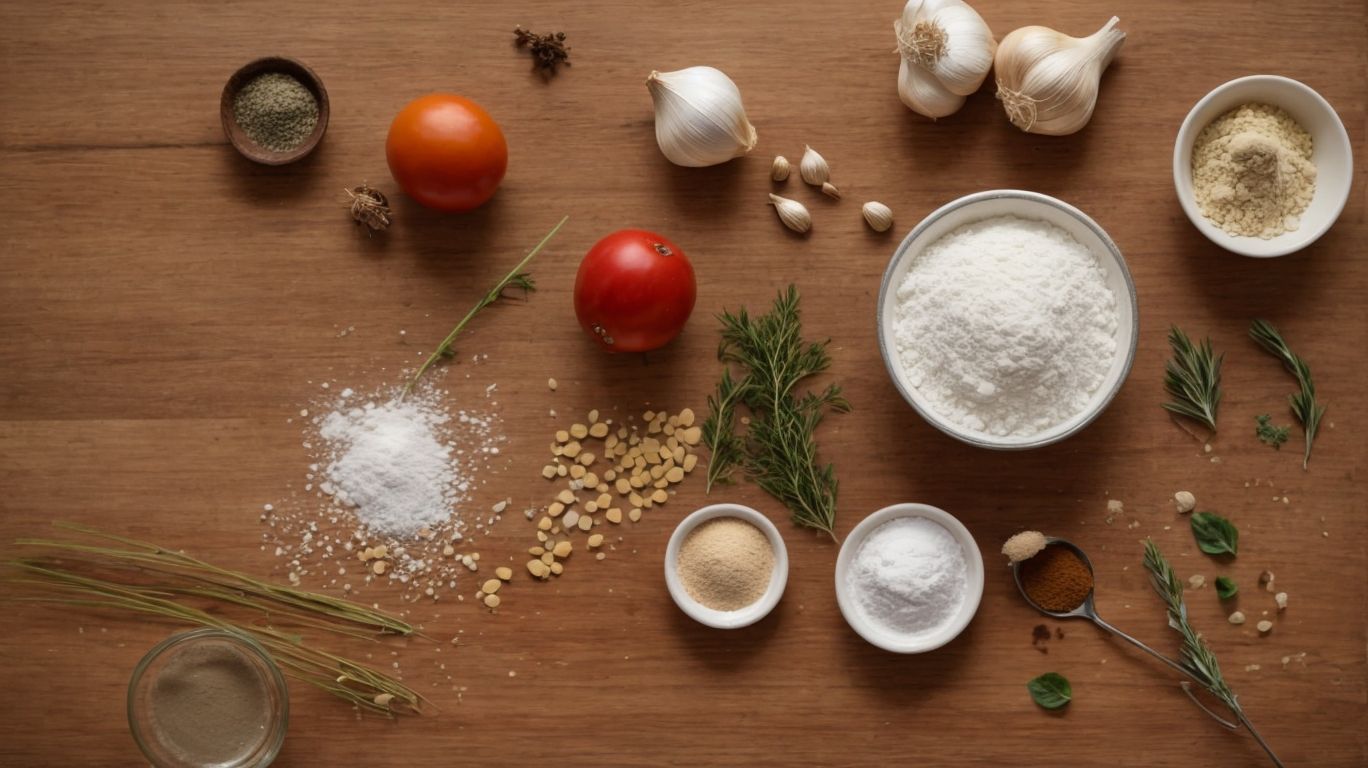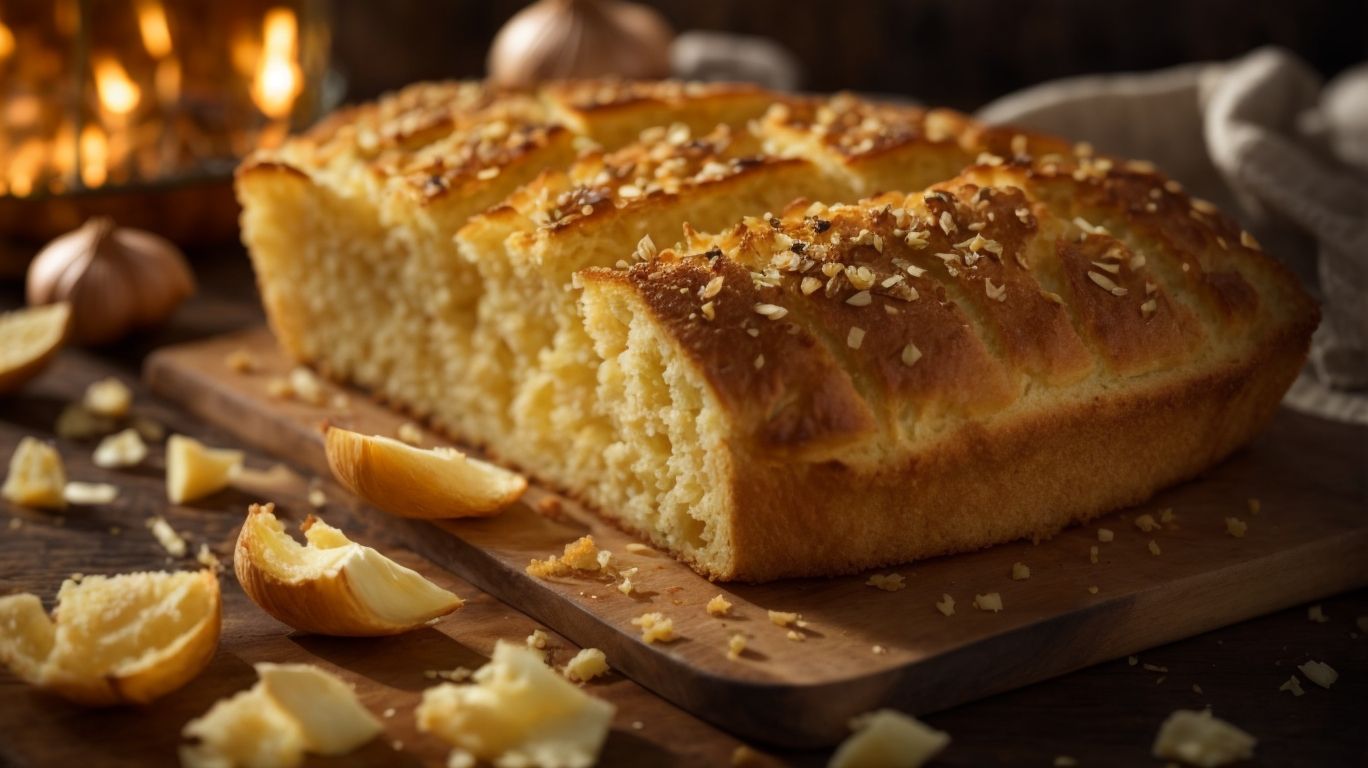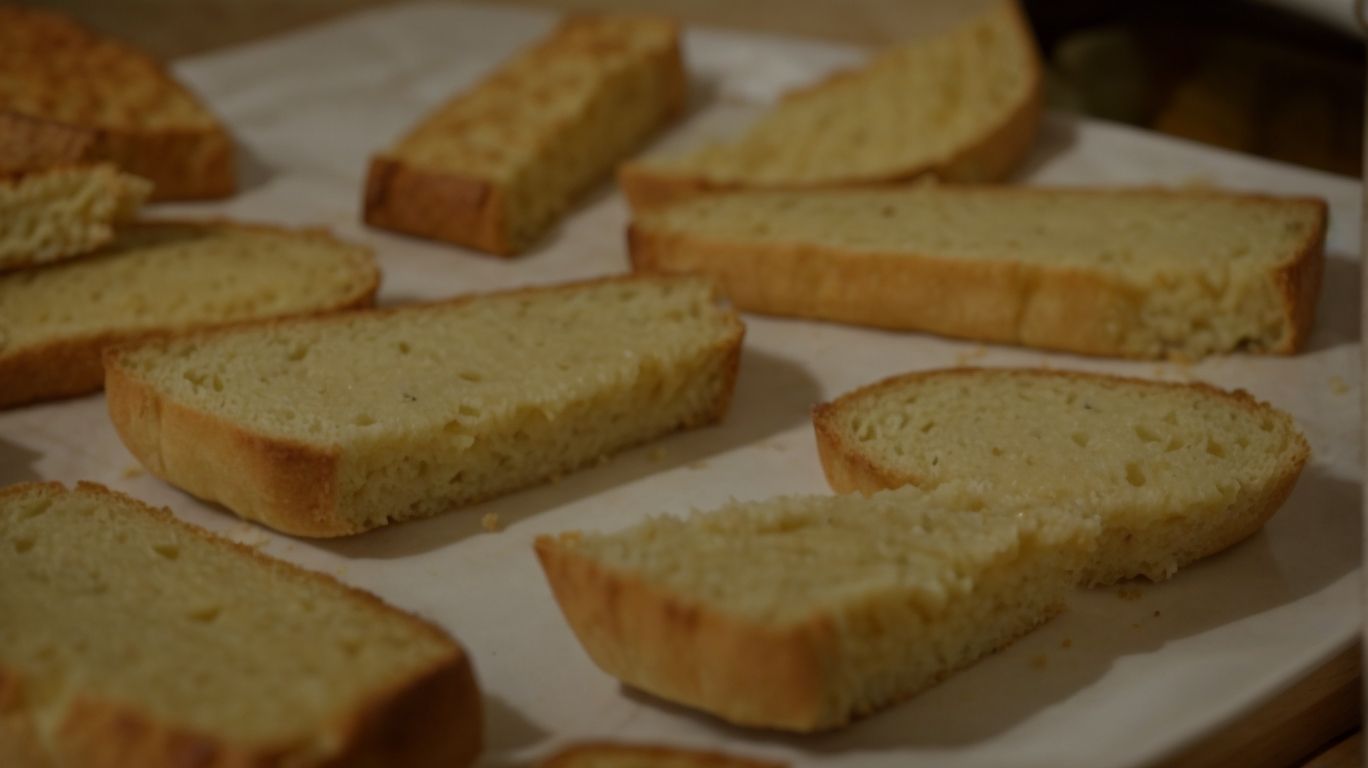How to Bake Garlic Bread Without Yeast?
Have you ever wondered what exactly yeast is and why it’s used in bread?
In this article, we’ll explore the different types of yeast and why some people choose to bake garlic bread without it.
We’ll also discuss whether yeast-free garlic bread is healthier and if it tastes different. From the ingredients needed to step-by-step instructions, alternative baking methods, and tips for achieving the perfect loaf, you’ll learn everything you need to know to enjoy delicious yeast-free garlic bread at home.
Key Takeaways:
What Is Yeast and Why Is It Used in Bread?
Yeast is a crucial ingredient in bread-making, responsible for the fermentation process that allows the dough to rise and creates the airy texture of breadsticks, homemade bread, and various recipes. Yeast acts as a leavening agent by consuming sugars and releasing carbon dioxide gas, which forms bubbles in the dough, resulting in a light and fluffy texture.
During the fermentation process, yeast converts the sugars present in the dough into alcohol and carbon dioxide. This carbon dioxide gas is trapped within the gluten network of the dough, causing it to expand and rise. The longer the dough is allowed to ferment, the more complex flavors develop.
Yeast contributes not only to the texture but also plays a significant role in developing the final flavor profile of the bread product. Understanding the science behind yeast activation and fermentation is essential for achieving the perfect loaf of bread.
What Are the Different Types of Yeast?
There are various types of yeast available for baking, including active dry yeast, instant yeast, and fresh yeast, each with its unique characteristics and requirements. Active dry yeast needs to be dissolved in warm water before use, while instant yeast can be directly added to the dry ingredients. Fresh yeast, also known as cake yeast, is perishable and requires refrigeration.
Active dry yeast is a popular choice among home bakers for its longer shelf life and versatility. It is best suited for recipes that require a longer rise time, such as traditional bread loaves. On the other hand, instant yeast is prized for its convenience as it does not need to be activated before mixing with other ingredients.
Fresh yeast, with its high moisture content, provides exceptional rise and a distinct flavor profile to breads. Because of its short shelf life, it is less commonly used in modern baking compared to active dry and instant yeast.
Why Bake Garlic Bread Without Yeast?
Baking garlic bread without yeast offers a quick and easy alternative for those seeking a no-yeast recipe.
This yeast-free version of garlic bread is ideal for individuals who may experience yeast sensitivities or are simply pressed for time in the kitchen. The absence of yeast not only caters to those with specific dietary needs but also significantly reduces the overall preparation time.
The flavor profile of yeast-free garlic bread tends to be more focused on the robust garlic and butter combination, as the absence of yeast allows these key ingredients to shine through with enhanced clarity.
The texture of yeast-free garlic bread can differ slightly from traditional recipes, with a denser and more compact crumb that provides a satisfying chewiness.
Is Yeast-Free Garlic Bread Healthier?
Yeast-free garlic bread can be perceived as a healthier alternative to traditional garlic bread recipes that use yeast. By eliminating yeast from the recipe, individuals with specific dietary preferences or restrictions can enjoy a lighter and potentially less bloat-inducing version of this classic dish. The overall healthiness of yeast-free garlic bread also depends on other ingredients and preparation methods used.
For instance, the choice of garlic plays a crucial role in the health implications of yeast-free garlic bread. Fresh garlic, known for its antimicrobial properties and potential cardiovascular benefits, can enhance the nutritional value of the dish.
Butter substitution with healthier options like olive oil or vegan spread can further elevate the health profile by reducing saturated fat content. Selecting herbs and spices rich in antioxidants not only enhances flavor but also adds nutritional value to the bread. By being mindful of ingredient selections, individuals can create a healthier version of garlic bread without compromising on taste.
Does Yeast-Free Garlic Bread Taste Different?
Yeast-free garlic bread offers a unique flavor profile compared to traditional yeast-based recipes.
The absence of yeast alters the texture and density of the bread, resulting in a slightly denser and more compact structure. Though it may lack the airy and light quality, yeast-free garlic bread makes up for it with a rich, savory garlic flavor that truly stands out. The bold garlic notes not only add depth but also create a satisfying umami taste that pairs well with various dishes. Incorporating alternative leavening agents like baking powder or baking soda enhances the rise of the bread without compromising its robust garlic essence.
Ingredients Needed for Yeast-Free Garlic Bread

Credits: Poormet.Com – Dennis Baker
To prepare yeast-free garlic bread, you will need a handful of simple ingredients commonly found in your pantry. The key components include flour, milk, garlic, butter, and seasonings such as salt and herbs. These basic ingredients combine to create a flavorful and aromatic garlic bread that is both easy to make and satisfying to enjoy.
Flour serves as the base for the breadsticks, providing structure and texture to the dough. It’s a staple in most households and readily available. Milk adds moisture and richness, enhancing the overall taste and creating a tender crumb. Garlic, with its pungent flavor, infuses the bread with a bold taste that garlic-lovers will adore. Butter adds a hint of richness and helps achieve that perfect golden-brown crust.
By blending these ingredients together, you can whip up a batch of homemade breadsticks with a delightful savory twist that is perfect for any occasion, from a casual family dinner to a festive gathering.
Step-by-Step Instructions for Making Yeast-Free Garlic Bread
Follow these step-by-step instructions to create delectable yeast-free garlic bread that is perfect for any occasion. From preparing the dough to adding flavorful garlic toppings and baking to perfection, this recipe will guide you through each stage of the baking process, ensuring that your garlic bread turns out fragrant, golden brown, and irresistibly delicious.
First, gather your ingredients, including flour, salt, baking powder, milk, and butter.
- Mix the dry ingredients in a bowl, then gradually add the wet ingredients to form a soft dough.
- Knead the dough until it’s smooth and elastic, which should take around 5-10 minutes.
- Next, roll out the dough into a rectangle and spread a generous amount of minced garlic and melted butter on top.
- Roll up the dough tightly, shape it into a loaf, and let it rest for about 10-15 minutes.
- In the meantime, preheat your oven to 375°F (190°C).
How to Make the Dough
Preparing the dough for yeast-free garlic bread requires a simple yet precise combination of flour, milk, butter, and garlic. Begin by mixing the dry and wet ingredients to form a smooth, elastic dough that is easy to work with and shape. The consistency of the dough plays a crucial role in determining the final texture and structure of the garlic bread, ensuring a satisfying bite with each slice.
Once the ingredients are well combined, it’s time to knead the dough to develop gluten and create that perfect texture. Kneading involves working the dough with your hands or a mixer until it becomes smooth and uniform. This process helps distribute the garlic and butter evenly throughout the dough, enhancing the flavor in every bite. After kneading, let the dough rest for a while to allow it to relax and rise slightly.
How to Add Garlic Flavor to the Bread
Infusing the yeast-free garlic bread with robust garlic flavor is a crucial step in elevating its taste profile. To achieve this, finely mince fresh garlic cloves and blend them with melted butter or olive oil to create a fragrant garlic spread. Brush this aromatic mixture over the prepared dough before baking to impart a rich, savory essence that permeates the breadsticks during baking.
Ensure that the garlic is minced finely to release maximum flavor and aroma into the butter/oil mixture, enhancing the overall taste of the garlic spread.
When applying the garlic spread onto the dough, use a pastry brush or the back of a spoon to distribute it evenly, ensuring that each breadstick is coated thoroughly. This not only ensures consistent flavor but also helps in achieving a golden, flavorful crust once baked.
Consider adding a sprinkle of parmesan cheese or herbs like parsley or oregano on top for an extra layer of flavor and visual appeal.
Alternative Methods for Baking Yeast-Free Garlic Bread
Aside from traditional yeast-free recipes, there are alternative methods for baking delicious garlic bread without yeast. These include using baking powder as a leavening agent to provide the bread with a light and airy texture, utilizing self-rising flour for convenience, or incorporating sour cream or yogurt to enhance the moisture and tenderness of the bread. Each method offers a unique twist to yeast-free garlic bread recipes.
Experimenting with different leavening agents not only alters the texture but also impacts the flavor profile of the garlic bread. Baking powder, known for its quick action, ensures a rapid rise in the dough, resulting in a fluffy and tender crumb. On the other hand, self-rising flour simplifies the recipe by already containing baking powder and salt, reducing the need for additional ingredients. Sour cream or yogurt, with their tangy richness, introduce a subtle tanginess and softness to the bread, making it a versatile choice for those looking for a unique twist on the classic garlic bread.
Using Baking Powder as a Leavening Agent
When baking yeast-free garlic bread, incorporating baking powder as a leavening agent offers a quick and reliable way to achieve a well-risen and tender loaf. Baking powder reacts with moisture and heat to release carbon dioxide gas, creating air pockets in the dough and resulting in a light and fluffy texture. This method is ideal for those seeking a convenient alternative to traditional yeast-based recipes.
For successful results, it is essential to maintain the right ratio of baking powder to flour in your recipe. Typically, a common ratio is about 1 to 1.5 teaspoons of baking powder per cup of flour. Mixing the baking powder evenly into the dry ingredients before adding them to the wet mix ensures proper distribution and activation during baking.
When using baking powder in yeast-free recipes, the batter or dough should be promptly placed in the oven after mixing to take advantage of the immediate leavening effect. Unlike yeast, which requires time to ferment and rise dough, baking powder acts quickly once heat is introduced.
Using Self-Rising Flour
Opting for self-rising flour when making yeast-free garlic bread simplifies the baking process and ensures a consistent rise and texture in the final product.
Self-rising flour contains a precise mix of baking powder and salt, which streamlines the ingredient list and reduces the chances of mismeasurement. This balanced combination not only helps the dough rise uniformly but also imparts a subtle saltiness that complements the garlic flavor in the breadsticks.
The convenience of using self-rising flour in your homemade breadsticks means you don’t have to worry about activating yeast or waiting for the dough to proof. This makes it an ideal choice for quick baking sessions or when you desire a fuss-free recipe.
Using Sour Cream or Yogurt as a Leavening Agent
Incorporating sour cream or yogurt as leavening agents in yeast-free garlic bread introduces a tangy richness and moisture to the baked product.
The acidity in sour cream or yogurt reacts with baking soda to produce carbon dioxide gas, resulting in a tender and flavorful bread. This method not only enhances the texture of the garlic bread but also adds a subtle tanginess that complements the garlic and butter flavors.
When using sour cream as a leavening agent, it’s essential to consider the acidity levels to balance the recipe. The creamy consistency of sour cream provides a moist crumb structure to the bread, making it soft and enjoyable to eat. Similarly, yogurt can also be utilized as a leavening agent, offering a similar tangy note with a slightly different texture profile.
Tips and Tricks for Perfect Yeast-Free Garlic Bread

Credits: Poormet.Com – Logan Martinez
Achieving the ideal yeast-free garlic bread involves following a few essential tips and tricks to ensure a perfect outcome. From kneading the dough to flavoring it with aromatic garlic and herbs, attention to detail and technique can elevate your garlic bread to a gourmet level. Incorporating these expert tips will help you master the art of baking yeast-free garlic bread with confidence and flair.
One crucial aspect to consider is the consistency of the dough. Ensure that your dough is well-balanced, not too sticky or too dry, for the best texture and rise.
When infusing garlic into the recipe, be generous with garlic cloves to achieve that rich, savory flavor.
Experiment with different baking times to find the perfect level of crispiness and softness in your breadsticks. Consider enhancing the flavor profile with a sprinkle of parmesan or a drizzle of olive oil before baking.
How to Achieve a Crispy Crust
Creating a crispy crust on yeast-free garlic bread involves a combination of baking techniques and ingredient choices. To achieve a golden and crunchy crust, consider brushing the dough with melted butter before baking and sprinkling a mixture of grated cheese and herbs on top. The cheese forms a flavorful crust while the butter enhances browning, resulting in a visually appealing and delicious finish.
For a more advanced technique in achieving an extra crispy crust, try adding a small amount of cornstarch to the dough mixture. The cornstarch creates a thin layer of crispiness when baked. Another tip is to bake the breadsticks on a preheated pizza stone or baking steel, helping to distribute heat evenly and create a professional bakery-style result.
How to Store and Reheat Yeast-Free Garlic Bread
Properly storing and reheating yeast-free garlic bread can help maintain its freshness and flavor for an extended period.
For optimal results, make sure to label the wrapped or stored garlic bread with the date to track its freshness. When refrigerating, keep the bread away from strong-smelling foods to prevent flavor transfer, wrap it tightly to avoid exposure to air and odors, store it in the middle shelves of the refrigerator for consistent temperature.
When it’s time to reheat the breadsticks, consider using an oven or toaster oven over a microwave to preserve their texture and crunchiness.
Conclusion: Enjoy Delicious Yeast-Free Garlic Bread at Home!
In conclusion, yeast-free garlic bread offers a convenient and flavorful option for baking enthusiasts and garlic bread lovers alike. By exploring alternative leavening methods, ingredient variations, and expert tips for preparation, you can create delicious garlic bread at home without the need for yeast. Embrace the versatility and creativity of yeast-free recipes to enjoy aromatic and mouthwatering garlic bread tailored to your preferences.
This type of bread opens up a world of possibilities in the kitchen, allowing for experimentation with different herbs, cheeses, and seasonings to enhance the garlic flavors and bring out your unique culinary style. Whether you prefer traditional breadsticks or artisanal loaves, yeast-free garlic bread offers the flexibility to customize every aspect of your baking experience, from the preparation process to the final presentation on the table.
Frequently Asked Questions
How to Bake Garlic Bread Without Yeast?
Yeast is a key ingredient in most bread recipes, but what if you don’t have any on hand? Don’t worry, you can still enjoy delicious garlic bread! Here are some FAQs on how to bake garlic bread without yeast.
Can I make garlic bread without yeast?
Yes, you can! There are various substitutes for yeast, such as baking powder, baking soda, or self-rising flour, that you can use to make garlic bread without yeast.
What is the best substitute for yeast in garlic bread?
If you don’t have yeast, the best substitute for garlic bread is baking powder. It will help the bread rise and give it a light, fluffy texture.
How much baking powder should I use to replace yeast in garlic bread?
The general rule of thumb is to use 1 teaspoon of baking powder for every 1 cup of flour. Keep in mind that this ratio may vary depending on the recipe and other ingredients used.
Can I use baking soda instead of baking powder in garlic bread?
Yes, you can use baking soda as a substitute for baking powder in garlic bread. However, you will need to use an acidic ingredient like lemon juice or vinegar to activate the baking soda and help the bread rise.
Is it possible to make garlic bread without any rising agent?
Yes, you can make a flatbread version of garlic bread without any rising agent. Simply mix together flour, salt, water, and garlic, then flatten the dough and bake it in the oven.

